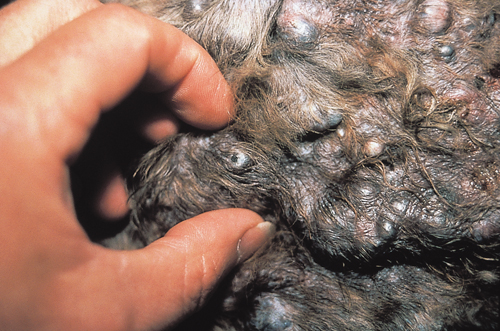Difference between revisions of "Small Animal Dermatology Q&A 01"
Ggaitskell (talk | contribs) |
|||
| Line 18: | Line 18: | ||
Oral retinoids (isotretinoin 1–3 mg/kg PO q24h) have been successful in the treatment of multiple keratoacanthomas in some dogs. Treatment responses may take up to 3 months and, if effective, need lifelong administration. <br><br> | Oral retinoids (isotretinoin 1–3 mg/kg PO q24h) have been successful in the treatment of multiple keratoacanthomas in some dogs. Treatment responses may take up to 3 months and, if effective, need lifelong administration. <br><br> | ||
Considered benign proliferations of skin epithelium, these lesions are benign, non-invasive, and do not metastasize. Dogs with generalized lesions have a strong tendency to develop new tumors at other sites. The generalized form is believed to have a hereditary basis in dogs. | Considered benign proliferations of skin epithelium, these lesions are benign, non-invasive, and do not metastasize. Dogs with generalized lesions have a strong tendency to develop new tumors at other sites. The generalized form is believed to have a hereditary basis in dogs. | ||
| − | |l1= | + | |l1= |
|q2=What is this the origin of these tumors? | |q2=What is this the origin of these tumors? | ||
|a2= | |a2= | ||
These tumors originate from the superficial epithelium between hair follicles although some may originate from adnexa. | These tumors originate from the superficial epithelium between hair follicles although some may originate from adnexa. | ||
| − | |l2= | + | |l2= |
|q3=If this tumor were aspirated, what would a cytological examination be expected to find? | |q3=If this tumor were aspirated, what would a cytological examination be expected to find? | ||
|a3= | |a3= | ||
| Line 32: | Line 32: | ||
*inflammatory cells if the mass has ruptured. <br> | *inflammatory cells if the mass has ruptured. <br> | ||
These tumors can be difficult to differentiate from inclusion cysts. | These tumors can be difficult to differentiate from inclusion cysts. | ||
| − | |l3= | + | |l3= |
</FlashCard> | </FlashCard> | ||
Revision as of 08:43, 6 June 2011
| This question was provided by Manson Publishing as part of the OVAL Project. See more small animal dermatological questions |
A 5-year-old male Norwegian elkhound dog with generalized confluent dermal masses is shown. The tumors are firm to fluctuant, well-circumscribed, dermal to subcutaneous masses varying in size from 0.5–>5.0 cm. Some of the lesions have visible pores opening onto the surface of the skin; the pores are filled with cutaneous plugs. The dog is otherwise healthy.
| Question | Answer | Article | |
| What is the most likely diagnosis, what treatment options are available, and what is the prognosis? | Keratoacanthoma (also called an intracutaneous cornifying epithelioma).
Solitary keratoacanthomas can be treated by surgical excision, cryotherapy, electrotherapy, and observation without treatment. Multiple lesions are usually too numerous for surgical excision. |
[[|Link to Article]] | |
| What is this the origin of these tumors? | These tumors originate from the superficial epithelium between hair follicles although some may originate from adnexa. |
[[|Link to Article]] | |
| If this tumor were aspirated, what would a cytological examination be expected to find? | Cytologically, these tumors are characterized by
These tumors can be difficult to differentiate from inclusion cysts. |
[[|Link to Article]] | |
